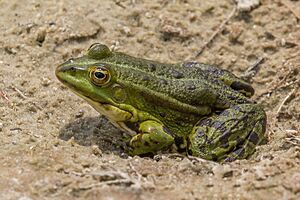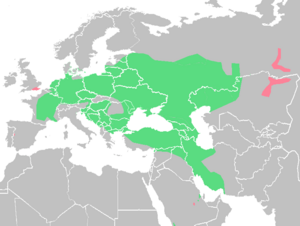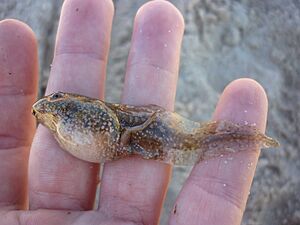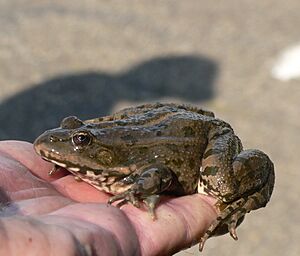Marsh frog facts for kids
Quick facts for kids Marsh frog |
|
|---|---|
 |
|
| Conservation status | |
| Scientific classification | |
| Genus: |
Pelophylax
|
| Species: |
ridibundus
|
 |
|
| Distribution | |
| Synonyms | |
|
Rana ridibunda Pallas, 1771 |
|
The marsh frog (Pelophylax ridibundus) is a type of water frog. These amazing amphibians are originally from Europe and parts of western Asia. They are known for their loud calls and their ability to live in many different watery places.

Contents
What Does a Marsh Frog Look Like?
The marsh frog is often the biggest frog in the areas where it lives. Male frogs can grow to about 100 mm (4 in) long from their snout to their rear. Female frogs are usually a bit bigger.
Their skin can be many different colors and patterns. They might be dark green, brown, or gray. Sometimes they have lighter green lines. A lighter line often runs down their back. In early spring, they usually look darker. This helps them soak up more heat from the sun.
Marsh frog tadpoles can grow very long, up to 190 mm (7.3 in). This usually happens in places with long winters. The long winter gives the tadpoles more time to grow big.
Where Do Marsh Frogs Live?
Marsh frogs live across a large part of Europe. You can find them from western France all the way to the Middle East and into Russia. There are also small groups of them in places like Saudi Arabia and the Russian Far East. Some marsh frogs have also been brought to new places, like the United Kingdom. These are called introduced populations.
These frogs are not picky about where they live. They can make their home in many different types of water. This includes ponds, lakes, rivers, and even ditches. During winter, marsh frogs hibernate. They might hide underwater or in burrows. They can even use the magnetic field of the Earth to find their way back to breeding ponds!
What Do Marsh Frogs Eat?
Adult marsh frogs have a big head and a wide mouth. This helps them eat many different kinds of food. They mostly eat arthropods and other small creatures without backbones. But they also eat small fish, other frogs, reptiles, tiny birds, and even small rodents.
Scientists studied marsh frogs in Thrace. They found that flies made up 40% of their diet. Beetles were another 20%. Marsh frogs have even been seen climbing on water buffalo. They do this to eat the flies that are attracted to the buffalo. This might be a type of mutualistic relationship, where both animals help each other.
When they are tadpoles, marsh frogs eat different things. They munch on algae, dead plant bits, decaying plants, tiny water creatures, and even dead animals.
Marsh Frog Hybrids
Sometimes, marsh frogs can breed with other types of water frogs. When they do, they can create special kinds of hybrid frogs. These hybrids are a mix of two different frog species.
For example, the edible frog is a hybrid of the pool frog and the marsh frog. Another hybrid is Graf's hybrid frog. This frog is a mix of the Perez's frog and the marsh frog. There is also the Italian edible frog, which is a mix of the Italian pool frog and the marsh frog.
These hybrid populations can keep going through a special process called hybridogenesis. In places where marsh frogs have been introduced, they might breed with local frogs. This could change the genes of the native frogs. However, studies show that even if they breed, they don't always cause big problems for the native frog populations.



